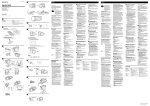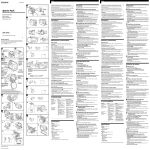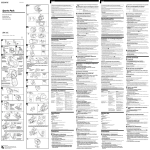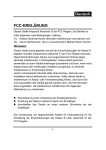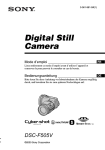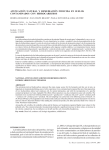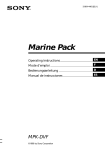Download Sony SPK-TRV7 User's Manual
Transcript
3-976-828-21(1) C Sports Pack 1 SPK-TRV7 This mark indicates that this products is a genuine accessory for Sony video products. When purchasing Sony video products, Sony recommends that you purchase accessories with this “GENUINE VIDEO ACCESSORIES” mark. 2 3 4 1 Operating Instructions Mode d’emploi Bedienunganleitung Istruzioni per l’uso Usable at a depth as low as 2 meters (6.5 feet) under water. 2 A The waterproof sports pack SPK-TRV7 can be used only with the Sony Handycam Vision™ camcorder DCR-TRV7. This sports pack is water- and moisture- resistant making it possible to use your camcorder in the rain or at the beach. 2 1 1 • Before you start recording, make sure that the camcorder is working correctly and there is no water leakage. • Sony does not accept liability for damage to the camcorder, battery, etc., when using the sports pack or for the cost of recording if water leakage occurs as a result of incorrect use. 2 Precaution 5 E 1 2 1 Mirror hood Viseur à miroir Buttons Camera mounting shoe Support de montage Bouton Zooming Réglage de la longueur focale Wide-angle Grand-angle 2 W T Telephoto Téléphoto • Do not subject the front glass to strong shock, as it may crack. • Avoid opening the sports pack in the sea or at the beach. Preparation such as installing and changing a cassette tape should be done in a place with low humidity and no salty air. • Do not throw the sports pack into the water. • Avoid using the sports pack under the following situations: – in a very hot or humid place. – in water hotter than 40˚C (104˚F). – at temperatures lower than 0˚C. In these situations moisture condensation or water leakage may occur and damage the equipment. • Use the sports pack for no longer than one hour at a time in temperatures above 35˚C (95˚F). • Do not leave the sports pack under direct sunlight for a long period of time. If you cannot avoid leaving the sports pack under direct sunlight, be sure to cover the pack with a towel or other protection. Before You Begin To make sure that you do not miss good shooting opportunities, go over the following checklist before installing your camcorder into the sports pack. F 3 2 πBattery pack πCassette tape 3 πWaterproof gasket G 1 2 2 3 • Fully charged. • The tape length will cover the planned recording time. • The tape is wound to the point where you want to start recording. • The safety tab on the cassette is in the correct position. (The red portion is not visible.) • No scratches or cracks. No dust, sand or hair around the gasket. • Correctly set in the groove. (See “Note on the Waterproof gasket” for details.) Maintenance and Precautions Water Leakage If water happens to leak in, stop exposing the sports pack to water immediately. If the camcorder gets wet, take it to the nearest Sony service facility immediately. 5 Note on the Waterproof Gasket 3, 4 5 Camera mounting shoe Support de montage Body Caisson 6 Guide H Tapering side up Côté effilé vers le haut Groove Rainure Sony Corporation ©1997 Printed in Japan • The useful life of the waterproof gasket depends upon the maintenance and the frequency of use, but we recommend changing it once a year. To replace the waterproof gasket, please consult the nearest Sony dealer. Be sure to check the water leakage after replacing the waterproof gasket. 5 Installing the camcorder. Checking for the water leakage after replacing the waterproof gasket 6 Set the POWER switch of the camcorder to CAMERA. Check for the water leakage before installing the camcorder. Close the sports pack without installing the camcorder, and keep the sports pack submerged under water at a depth of about 15 cm (6 inches) for about 3 minutes and then check for water leakage. 7 Close the rear body. Notice D B Français English • Check that there are no scratches or cracks on the waterproof gasket as they may allow water to leak in. If there are scratches or cracks, replace the damaged waterproof gasket with a new one. Do not remove the waterproof gasket with a metal tool or a tool with a sharp point. • Remove foreign materials such as dust, sand or hair from the waterproof gasket, the groove and from any surface the gasket touches. If the body is closed with such materials present, these areas may be damaged and water may leak in. • Put the waterproof gasket in the grooves evenly, with the tapering side up. Never twist it. (See illustration H) • After checking that there are no cracks or dust on the waterproof gasket, coat it slightly with the supplied grease using your finger. This will prevent wearing. While applying the grease, recheck for cracks or dust. Never use cloth or paper for greasing as the fibers may cling. Do not use any type of grease other than that supplied, as it may damage the waterproof gasket. 1 Align the camera mounting shoe with the guide on the front body. 2 Insert the camcorder by pushing the rear of the camera mounting shoe until it clicks. Check the knob on each side of the camera mounting shoe to ensure that it locked properly. (See illustration B5.) Before closing the unit, check there is no dust, sand or cracks on the waterproof gasket or the surface where it touches, and grease them slightly. Then secure the rear body, and fasten the buckles until they click. C Preparing the Sports Pack After Recording After recording in a location subject to sea breezes, wash the sports pack with fresh water with the buckles fastened thoroughly, then wipe with a soft dry cloth. If water remains on the sports pack, the metal parts may rust. Clean the inside of the pack with a soft dry cloth. Do not wash the inside of the pack. Do not use any type of solvent such as alcohol, benzine or shinner for cleaning, as this might damage the finish. Before opening the sports pack, wipe moisture off the sports pack and yourself. Do not allow water on the camcorder. 1 Release the buckles, and open the rear body. (See illustration B2) 2 Set the POWER switch of the camcorder to OFF. 3 Disconnect the remote control plug from the LANC l (remote) jack. Holding the camera mounting shoe by the knobs, take out the camcorder. Stop taking out the camcorder at the point where the remote control plug comes out from the sports pack. 4 Disconnect the MIC plug from the MIC jack. 5 Detach the camera mounting shoe. 1 Adjust the grip strap. Holding the sports pack so that the tips of your finger can easily touch the POWER switch, START/STOP button and ZOOM button, pull the strap to adjust its length. 2 Attach the shoulder strap. The Sony mark should be on the outside. Le caisson étanche SPK-TRV7 peut uniquement être utilisé avec un caméscope Sony Handycam Vision™ DCR-TRV7. Comme ce caisson étanche est résistant à l’eau et aux moisissures, il vous permet d’utiliser votre caméscope sous la pluie ou encore à la plage. Remarques • Avant d’entamer vos prises de vue, assurez-vous que le caméscope fonctionne correctement et qu’il n’y a aucune fuite d’eau. • Sony ne peut être tenu responsable pour tout dommage au caméscope, à la batterie, etc., survenant lors de l’utilisation du caisson étanche ou pour le coût des prises de vue à la suite d’une fuite d’eau résultant d’une utilisation incorrecte. • Ne soumettez pas la vitre frontale du caisson à des chocs violents, car elle pourrait se briser. • N’ouvrez pas le caisson sous l’eau ou sur la plage. Les préparatifs tels que l’installation et le remplacement d’une cassette doivent être effectués dans un lieu protégé contre l’humidité et l’air marin. • Ne jetez pas le caisson étanche dans l’eau. • Evitez d’utiliser le caisson étanche dans les conditions suivantes : – dans un endroit très chaud ou très humide. – dans de l’eau à plus de 40 °C (104 °F). – sous des températures inférieures à 0 °C. Dans de telle conditions, de la condensation d’humidité ou des fuites d’eau risquent en effet de se produire et d’endommager l’appareil. • N’utilisez pas le caisson étanche pendant plus d’une heure d’affilée sous des températures supérieures à 35 °C (95 °F). • Ne laissez pas le caisson étanche exposé au rayonnement direct du soleil pendant une période prolongée. Si vous ne pouvez éviter de laisser le caisson étanche sous le rayonnement direct du soleil, recouvrez-le d’une serviette ou de toute autre protection. 1 Turn the POWER switch to CAMERA. 2 Press START/STOP button to start recording. When storing the sports pack • Close the pack without fastening the buckles to prevent wear of the waterproof gasket. • Prevent dust from collecting on the waterproof gasket. • Avoid storing the sports pack in a cold, very hot or humid place, or together with naphthalene or camphor, as these conditions might damage the unit. Specifications To stop recording Press START/STOP . Press again to resume recording. To finish recording Press START/STOP button then turn the POWER switch to OFF. E When Shooting with the LCD Screen Material Plastic (PC, ABS), glass 1 Slide the mirror hood while holding the PULL mark and open it. Waterproof Waterproof gasket, buckles 2 Open the wings and insert the projections into each hole. Built-in microphone Stereo Dimension Approx. 169 x 174 x 226 mm (w / h / d) (6 3/4 x 6 7/8 x 9 inches) To close the mirror hood Avant de commencer Push the buttons to close the wings. (See illustration E2.) Close the upper wing first, and insert the projection on the upper wing into the hole on the lower wing. Mass Approx. 880 g (1 lb 15 oz) (only sports pack) Supplied accessories Shoulder strap (1) Camera mounting shoe (1) Grease (1) Anti-fogging lens solution (1) Operating Instructions (1) Pour être sûr de ne rater aucune possibilité de prises de vue intéressantes, parcourez la liste de contrôle suivante avant d’installer votre caméscope dans le caisson étanche. πBatterie • Complètement chargée πCassette • La longueur de bande est suffisante pour la durée de prise de vue envisagée. • La cassette est rembobinée à l’endroit où vous voulez démarrer la prise de vue. • Le taquet de sécurité de la cassette est réglé sur la position correcte. (La portion rouge est dissimulée.) πJoint d’étanchéité • Pas d’égratignures ni de fissures. Pas de poussière, de sable ou de cheveux sur le joint d’étanchéité. • Correctement inséré dans la rainure. (Pour plus de détails, voir “Remarques sur le joint d’étanchéité”.) Zooming • Keep the W side pressed for wide-angle. • Keep the T side pressed for telephoto. Press it gently for a relatively slow zoom. Notes on recording • If you leave the camcorder for 5 minutes or more with a cassette inserted in Standby mode, the camcorder goes off automatically. This prevents battery and tape wear. To resume Standby mode, turn the POWER switch to OFF and then turn it to CAMERA again. • During recording when the LCD screen is facing out, the counter does not appear. Design and specifications subject to change without notice. Preparing A Preparing the Camcorder F Playing Back with the For details, please refer to the operating instructions supplied with your camcorder. Remote Commander 1 Remove the shoulder strap, filter or conversion lens from the camcorder. 2 Hold the eyecap. You can play back pictures on the LCD screen, using the Remote Commander (supplied with your camcorder). 3 Install the battery pack. 1 Set the mirror hood. 4 Insert the cassette tape. 5 When shooting with the LCD screen, turn the LCD panel over and move back to the camcorder with the LCD screen facing out. 6 Set the AUTO LOCK switch up. Entretien et précautions Fuites d’eau See “E When Shooting with the LCD Screen”. Si de l’eau s’infiltre dans le caisson étanche, mettez-le immédiatement à l’abri de l’eau. Si le caméscope est mouillé, présentez-le immédiatement au centre de service après-vente Sony le plus proche. 2 Turn the POWER switch to PLAYER. 3 Press ( PLAY on the remote. Use the remote commander for all other functions including STOP, REW and FF. Remarques sur le joint d’étanchéité 7 Set the FOCUS switch to AUTO. Note 8 Set the finder power save function to OFF in the menu. The picture on the mirror looks turned sideways. . B Installing the Camcorder Trouble Check 1 Attach the camera mounting shoe. Use the metal parts of shoulder strap as shown in the illustration. 2 Release the buckles. 1 Slide the unlock button in the direction of the arrow, and release the buckles. 2 Open the rear body. 4 Turn the viewfinder up. Utilisable à une profondeur de 2 mètres (6,5 pieds) sous l’eau. Using the Sports Pack D Recording Coat the surface of the glass with the supplied anti-fogging lens solution. This is effective in preventing from fogging. 3 Connect the microphone plug to MIC (plug in power) jack (1), and the remote control plug to LANC l (remote) jack (2). Ce symbole indique que ce produit est un accessoire original pour produits vidéo Sony. Quand vous achetez un produit Sony, nous vous recommandons de vous procurer des produits marqués “GENUINE VIDEO ACCESSORIES”. Précautions Preventing the surface of the glass from fogging up 9 Set the START/STOP MODE switch to G Removing the Camcorder Symptom Cause Corrective Actions The sound is not recorded. The microphone plug is not connect. Connect it to MIC (plug in power) jack on the camcorder. There are drop of water inside of the sports pack. • The buckles are not fastened. • The waterproof gasket is not incorrect. • There are scratches or cracks on the waterproof gasket. • Fasten the buckles until they click. • Put the gasket in the groove evenly. • The battery pack is run out. • The tape has run out. • The safety tab on the cassette is out. • Charge the battery pack fully. • Rewind the tape or use a new one. • Slide the safety tab or install a new cassette tape. The recording and playing back function does not work. • Replace the gasket with a new one. • Vérifiez s’il n’y a pas d’égratignures ni de fissures sur le joint d’étanchéité, car de l’eau pourrait sinon s’infiltrer dans le caisson. Si le joint d’étanchéité est égratigné ou fissuré, remplacez-le. Ne retirez pas le joint d’étanchéité au moyen d’un ustensile en métal ni d’un ustensile pointu. • Eliminez les corps étrangers tels que la poussière, le sable ou les cheveux du joint d’étanchéité, de la rainure et de toutes les surfaces en contact avec le joint d’étanchéité. Si le caisson est refermé en présence de tels corps étrangers, il se peut que les zones en question risquent d’être endommagées et de l’eau de s’infiltrer. • Insérez le joint d’étanchéité uniformément dans la rainure avec la partie effilée vers le haut. Ne le torsadez en aucun cas. (Voir illustration H.) • Après avoir vérifié s’il n’y a aucune fissure ni de poussière sur le joint d’étanchéité, recouvrez-le avec le doigt d’une légère couche de la graisse fournie, de façon à le protéger contre l’usure. Lorsque vous appliquez la graisse, revérifiez la présence éventuelle de fissures ou de poussière. N’utilisez pas de chiffon ou de papier pour graisser le joint d’étanchéité parce que des fibres risquent sinon d’adhérer au joint. N’utilisez aucun autre type de graisse que la graisse fournie, car vous risqueriez sinon d’endommager le joint d’étanchéité. • La durée de vie utile du joint d’étanchéité dépend de l’entretien et de la fréquence d’utilisation, mais nous vous conseillons de le remplacer une fois par an. Pour le remplacement du joint d’étanchéité, veuillez vous adresser à votre revendeur Sony. Vérifiez la présence éventuelle de fuites d’eau après le remplacement du joint d’étanchéité. B Installation du caméscope Zoom 1 Fixez le sabot de montage du caméscope. • Appuyez sur le côté “W” de la touche enfoncée pour élargir l’angle de prise de vue. • Appuyez sur le côté “T” de la touche pour les prises de vue au téléobjectif. Appuyez légèrement sur la touche pour un zoom relativement lent. Vérification de la présence éventuelle de fuites d’eau après le remplacement du joint d’étanchéité 4 Relevez le viseur. Vérifiez la présence éventuelle de fuites d’eau avant d’installer le caméscope. Refermez le caisson étanche sans installer le caméscope à l’intérieur et laissez le caisson étanche immergé dans l’eau à une profondeur d’environ 15 cm (6 pouces) pendant approximativement 3 minutes et vérifiez ensuite la présence éventuelle de fuite d’eau. Après la prise de vue Après une prise de vue dans un endroit soumis à la brise marine, rincez le caisson étanche à l’eau douce avec les boucles soigneusement fermées, et essuyez-le ensuite à l’aide d’un chiffon doux et sec. Si de l’eau reste sur le caisson étanche, les éléments métalliques risquent de se corroder. Nettoyez l’intérieur du caisson au moyen d’un chiffon doux et sec. Ne rincez pas l’intérieur du caisson étanche. N’utilisez aucun type de solvant tel que de l’alcool, du benzène ou de produit à polir pour le nettoyage, car ils risqueraient de ternir le fini du caisson. Pour empêcher la formation de buée sur la vitre Appliquez à la surface de la vitre un peu de la solution antibuée pour objectif fournie. Cette solution est un moyen efficace pour éviter la formation de buée sur la vitre. Rangement du caisson étanche Utilisez les éléments métalliques de la bandoulière comme indiqué dans l’illustration. 2 Desserrez les boucles. 1 Faites glisser le bouton de déverrouillage dans le sens de la flèche et desserrez les boucles. 2 Ouvrez l’élément arrière du caisson. 3 Branchez la fiche du microphone sur la prise MIC (auto-alimentée) (1) et la fiche de télécommande sur la prise LANC l (télécommande) (2). 5 Installation du caméscope. 1 Alignez le sabot de montage du caméscope sur le guide du corps avant du caisson. 2 Introduisez le caméscope en poussant l’arrière du sabot de montage du caméscope jusqu’à ce qu’il s’encliquette. Vérifiez si les molettes situées de part et d’autre du sabot de montage du caméscope sont correctement serrées. (Voir illustration B5.) 6 Réglez le commutateur POWER du caméscope sur CAMERA. 7 Refermez l’élément arrière du caisson. Avant de refermer le caisson étanche, vérifiez s’il n’y a pas de poussière, de sable ni d’égratignures sur le joint d’étanchéité ou les surfaces en contact avec le joint et graissez-le légèrement. Fixez ensuite l’élément arrière et serrez les boucles jusqu’à ce qu’elles s’encliquettent. C Préparation du caisson étanche 1 Ajustez la sangle de maintien. Saisissez le caisson étanche de façon à ce que vos doigts atteignent facilement le commutateur POWER, la touche START/ STOP et la touche ZOOM. Tirez sur la sangle pour l’ajuster à la longueur adéquate. 2 Fixez la sangle de maintien. La marque Sony doit être orientée vers l’extérieur. Utilisation du caisson étanche Spécifications 2 Appuyez sur la touche START/STOP pour démarrer l’enregistrement. Etanchéité Joint d’étanchéité, boucles Microphone intégré Stéréo • Si vous laissez le caméscope pendant 5 minutes ou plus en mode de veille avec une cassette à l’intérieur, le caméscope s’arrête automatiquement de façon à prévenir l’usure de la batterie et de la bande magnétique. Pour réactiver le mode de veille, réglez le commutateur POWER sur OFF et puis ensuite à nouveau sur CAMERA. • Durant les prises de vue réalisées avec l’écran LCD orienté vers l’extérieur, le compteur n’apparaît pas. F Lecture avec la télécommande Vous pouvez commander la lecture des images sur l’écran LCD à l’aide de la télécommande (fournie avec votre caméscope). 1 Préparez le viseur à miroir. Voir “E Réalisation de prises de vue avec l’écran LCD”. 2 Réglez le commutateur POWER sur PLAYER. 3 Appuyez sur la touche ( PLAY de la télécommande. Utilisez la télécommande pour toutes les autres fonctions, y compris STOP, REW et FF. Remarque Sur le miroir, l’image apparaît inversée. • Refermez le caisson sans serrer les boucles de façon à éviter toute usure intempestive du joint d’étanchéité. • Evitez l’accumulation de poussière sur le joint d’étanchéité. • Ne rangez pas le caisson étanche dans un endroit froid, très chaud ou humide ou encore en présence de naphtaline ou de camphre, car cela risque d’occasionner des dommages au caisson. Matériau Plastique (PC, ABS), verre Remarques sur la prise de vue D Réalisation de prises de vue 1 Réglez le commutateur POWER sur CAMERA. G Dépose du caméscope Avant d’ouvrir le caisson étanche, essuyez les traces d’humidité sur le caisson étanche et vos mains. Veillez à ne pas mouiller le caméscope. 1 Desserrez les boucles et ouvrez l’élément arrière du caisson. (Voir illustration B2) 2 Réglez le commutateur POWER du caméscope sur OFF. 3 Débranchez la fiche de la télécommande de la prise LANC l (télécommande). Tout en maintenant le sabot de montage du caméscope par les molettes, extrayez le caméscope du caisson. Arrêtez le caméscope à l’endroit où la fiche de télécommande sort du caisson étanche. 4 Débranchez la fiche MIC de la prise MIC. 5 Déposez le sabot de montage du caméscope. Pour arrêter l’enregistrement Appuyez sur START/STOP. Appuyez à nouveau sur la touche pour reprendre l’enregistrement. Pour terminer l’enregistrement Dimensions Approx. 169 x 174 x 226 mm (l / h / p) (6 3/4 x 6 7/8 x 9 pouces) Appuyez sur la touche START/STOP et réglez ensuite le commutateur POWER sur OFF. Masse Approx. 880 g (1 lb 15 oz) (caisson étanche seul) E Réalisation de prises de vue Accessoires fournis Bandoulière (1) Sabot de montage de caméra (1) Graisse (1) Solution antibuée pour objectif (1) Mode d’emploi (1) 1 Faites glisser le viseur à miroir tout en maintenant le repère PULL et ouvrez-le. avec l’écran LCD 2 Ouvrez les volets et insérez les saillies dans chaque orifice. Pour refermer le viseur à miroir La conception et les spécifications sont sujettes à modifications sans préavis. Préparation Appuyez sur les boutons pour refermer les volets. (Voir illustration E2.) Refermez d’abord le volet supérieur et insérez ensuite la saillie du volet supérieur dans l’orifice du volet inférieur. A Préparation du caméscope Pour plus de détails, consultez le mode d’emploi fourni avec votre caméscope. 1 Retirez la bandoulière, le filtre ou le convertisseur d’objectif du caméscope. Guide de dépannage 2 Maintenez l’oculaire. 3 Installez la batterie. Symptôme Cause Mesures correctives 4 Introduisez la cassette. Le son n’est pas enregistré. 5 Pour les prises de vue avec l’écran LCD, retournez le panneau de l’écran LCD et ramenez-le contre le caméscope avec l’écran LCD orienté vers l’extérieur. La fiche du microphone n’est pas branchée. Branchez-la sur la prise MIC (autoalimentée) du caméscope. Il y a des gouttes à l’intérieur du caisson étanche. • Les boucles ne sont pas serrées. • Le joint d’étanchéité n’est pas correctement installé. • Le joint d’étanchéité est égratigné ou fissuré. • Serrez les boucles jusqu’à ce qu’elles s’encliquettent. • Insérez correctement le joint d’étanchéité dans la rainure. • Remplacez le joint d’étanchéité. La fonction d’enregistrement/lecture est inopérante. • La batterie est épuisée. • Chargez la batterie à fond. • La cassette est en fin de bande. • Rembobinez la cassette ou utilisez-en une autre. • Le taquet de sécurité de la • Faites coulisser le taquet de sécurité cassette est mal réglé. de la cassette ou utilisez-en une autre. 6 Relevez le commutateur AUTO LOCK. 7 Réglez le commutateur FOCUS sur AUTO. 8 Réglez la fonction d’économie d’énergie du viseur sur OFF dans le menu. 9 Réglez le commutateur START/STOP MODE sur . A C 2 1 1 Diese Markierung gibt, an, daß es sich bei diesem Produkt um ein spezielles Zubehör für Sony Videogeräte handelt. Beim Kauf eines Sony Videogeräts empfehlen wir, darauf zu achten, daß es mit „GENUINE VIDEO ACCESSORIES” markiert ist. 2 3 4 1 Bis in 2 m Wassertiefe einsetzbar. 2 5 Das wasserdichte Sportgehäuse SPK-TRV7 ist nur für den Camcorder Handycam Vision™ DCR-TRV7 von Sony geeignet. Dieses Sportgehäuse schützt den Camcorder vor Wasser und Feuchtigkeit, so daß sie ihn auch bei Regen oder am Strand verwenden können. Hinweise B D 1 1 • Vergewissern Sie sich vor dem Starten der Aufnahme, daß der Camcorder einwandfrei arbeitet und kein Wasser eindringt. • Sony übernimmt keine Haftung für den im Sportgehäuse eingesetzten Camcorder, Akku usw. und ersetzt keine Aufnahmekosten, wenn aufgrund falscher Bedienung Wasser in das Gehäuse eindringt. 2 Sicherheitsmaßnahmen Montageschuh Attacco di montaggio videocamera E 2 2 1 Spiegelblende Coprispecchietto Taste Tasto 3 Zoomen Zoomata Weitwinkle Grandangolo W T Tele Teleobiettivo • Schützen Sie das Glas an der Vorderseite vor Stößen, da es sonst zerspringen könnte. • Öffnen Sie das Sportgehäuse nicht unter Wasser oder am Strand. Vorbereitungen wie Einlegen oder Wechseln einer Kassette sollten Sie an einem Ort ausführen, an dem das Gerät keiner Feuchtigkeit und keiner salzigen Seeluft ausgesetzt wird. • Werfen Sie das Sportgehäuse nicht ins Wasser. • Verwenden Sie das Sportgehäuse möglichst nicht in folgenden Fällen: – an einem sehr heißen oder feuchten Ort. – in Wasser mit einer Temperatur über 40 °C. – bei Temperaturen unter 0 °C. Andernfalls kann sich Feuchtigkeit niederschlagen oder Wasser eindringen und das Gerät beschädigen. • Verwenden Sie das Sportgehäuse bei Temperaturen über 35 °C nicht länger als eine Stunde. • Lassen Sie das Sportgehäuse nicht längere Zeit in direktem Sonnenlicht liegen. Sollten Sie jedoch keinen schattigen Platz finden, schützen Sie das Gehäuse zumindest mit einem Handtuch o. ä. vor direkter Sonne. Vorbereitungen F 1 2 Damit der Camcorder immer zum Aufnehmen bereit ist, gehen Sie die folgende Checkliste durch, bevor Sie den Camcorder in das Sportgehäuse einsetzen. 3 2 • Vollständig geladen. • Die Bandlänge muß für die geplante Aufnahmedauer ausreichen. • Das Band wurde an die Stelle gespult, an der die Aufnahme starten soll. • Die Überspielschutzlasche der Kassette muß sich in der richtigen Position befinden, d. h. die rote Markierung darf nicht sichtbar sein. πDichtung • Die Dichtung darf keine Risse oder Kratzer aufweisen. Sie muß frei von Staub, Sand oder Haaren sein. • Die Dichtung muß richtig in der Kerbe sitzen (siehe “Hinweise zur Dichtung”). πAkku πKassette 5 Montageschuh Attacco di montaggio videocamera Gehäuse Corpo G 2 Führung Guida Italiano Deutsch 3 Wartung und Sicherheitsmaßnahmen Eindringen von Wasser Wenn Wasser eindringt, nehmen Sie das Sportgehäuse umgehend aus dem Wasser! Wenn der Camcorder naß wird, bringen Sie ihn umgehend zum nächsten Sony-Kundendienst. 6 3, 4 Hinweise zur Dichtung 5 H Spitz zulaufende Seite nach oben Lato appuntitio verso l’alto Rille Scanalature • Überprüfen Sie, daß die Dichtung keine Kratzer oder Risse aufweist. Andernfalls kann Wasser eindringen. Bei Kratzern oder Rissen tauschen Sie die beschädigte Dichtung gegen eine neue aus. Nehmen Sie die Dichtung nicht mit einem metallenen oder spitzen Werkzeug ab. • Entfernen Sie Fremdkörper wie Staub, Sand oder Haare von der Dichtung, der Kerbe und allen Oberflächen, mit denen die Dichtung in Berührung kommt. Wenn solche Fremdkörper vorhanden sind und Sie das Gehäuse schließen, können diese Oberflächen beschädigt werden, und Wasser kann eindringen. • Legen Sie die Dichtung mit der spitz zulaufenden Seite nach oben gleichmäßig in die Kerbe ein, und verdrehen Sie sie nicht (siehe Abbildung H). • Nachdem Sie überprüft haben, daß die Dichtung frei von Kratzern oder Staub ist, fetten Sie sie leicht mit dem mitgelieferten Fett ein, das Sie mit dem Finger auf der Dichtung verteilen. Das Fett verhindert eine vorzeitige Abnutzung. Überprüfen Sie die Dichtung beim Einfetten nochmals auf Kratzer und Staub. Verwenden Sie zum Einfetten unter keinen Umständen ein Tuch oder Papier, da sonst Fasern an der Dichtung haftenbleiben könnten. Verwenden Sie ausschließlich das mitgelieferte Fett. Andernfalls kann die Dichtung beschädigt werden. • Die Nutzungsdauer der Dichtung hängt von der Pflege und der Häufigkeit des Gebrauchs ab. Es empfiehlt sich jedoch, sie jährlich auszutauschen. Wenden Sie sich dazu an Ihren Sony-Händler. Vergewissern Sie sich nach dem Austauschen der Dichtung, daß kein Wasser eindringen kann. B Einsetzen des Camcorders Zoomen 1 Bringen Sie den Kameramontageschuh an. • Halten Sie für Weitwinkelaufnahmen die WSeite gedrückt. • Halten Sie für Telephotoaufnahmen die T-Seite gedrückt. Drücken Sie die Taste für einen relativ langsamen Zoom nur leicht. So überprüfen Sie das Gehäuse nach dem Austauschen der Dichtung auf eindringendes Wasser 4 Klappen Sie den Sucher nach oben. Überprüfen Sie vor dem Einsetzen des Camcorders, ob Wasser in das Gehäuse eindringen kann. Schließen Sie das leere Sportgehäuse, und tauchen Sie es etwa 3 Minuten lang ca. 15 cm tief in Wasser ein. Überprüfen Sie anschließend, ob Wasser eindringen konnte. Nach dem Aufnehmen Nach Aufnahmen an Orten, an denen das Gehäuse der Seeluft ausgesetzt war, waschen Sie es bei fest verschlossenen Verschlußklappen mit Süßwasser ab. Wischen Sie es dann mit einem trockenen, weichen Tuch ab. Wenn Wasser auf dem Sportgehäuse zurückbleibt, besteht die Gefahr, daß die Metallteile rosten. Reinigen Sie das Innere des Gehäuses mit einem weichen, trockenen Tuch. Waschen Sie das Innere des Gehäuses nicht aus. Verwenden Sie keine Lösungsmittel wie Alkohol, Benzin oder Verdünner. Diese könnten die Oberfläche angreifen. So vermeiden Sie, daß das Frontglas beschlägt Bringen Sie das mitgelieferte Antibeschlagmittel auf dem Frontglas an. Dadurch kann das Beschlagen verhindert werden. Aufbewahren des Sportgehäuses • Schließen Sie das Gehäuse, ohne die Verschlußklappen zu befestigen. So verhindern Sie die Abnutzung der Dichtung. • Sorgen Sie dafür, daß die Dichtung nicht verstaubt. • Bewahren Sie das Sportgehäuse nicht an einem Ort aus, an dem es Kälte, starker Hitze, Feuchtigkeit, Naphthalin oder Kampfer ausgesetzt ist. Andernfalls kann das Produkt beschädigt werden. Technische Daten Material Kunststoff (PC, ABS), Glas Wasserdicht Dichtung, Verschlußklappen Eingebautes Mikrofon Stereo Abmessungen ca. 169 x 174 x 226 mm (B/H/T) Gewicht ca. 880 g (nur Sportgehäuse) Mitgeliefertes Zubehör Schulterriemen (1) Kameramontageschuh (1) Fett (1) Antibeschlagmittel (1) Bedienungsanleitung (1) Verwenden Sie die Metallteile des Schulterriemens wie in der Abbildung dargestellt. 2 Lösen Sie die Verschlußklappen. 1 Schieben Sie die Lösetaste in Pfeilrichtung, und lösen Sie so die Verschlußklappen. 2 Öffnen Sie das Gehäuse hinten. 3 Schließen Sie den Mikrofonstecker an die Buchse MIC (plug in power) (1) und den Fernbedienungsstecker an die Fernsteuerbuchse LANC l (2) an. 5 Setzen Sie den Camcorder ein. 1 Richten Sie den Kameramontageschuh an der Führungsschiene vorne am Gehäuse aus. 2 Setzen Sie den Camcorder ein, indem Sie hinten am Kameramontageschuh schieben, bis er mit einem Klicken einrastet. Überprüfen Sie den Knopf an beiden Seiten des Kameramontageschuhs, und vergewissern Sie sich, daß er ordnungsgemäß arretiert ist (siehe Abbildung B5). 6 Stellen Sie den Schalter POWER am Camcorder auf CAMERA. 7 Schließen Sie das Gehäuse hinten. Vergewissern Sie sich vor dem Schließen des Gehäuses, daß sich keine Kratzer, Staub oder Sand an der Dichtung oder den von der Dichtung berührten Oberflächen befinden, und fetten Sie sie leicht ein. Sichern Sie dann das Gehäuse hinten, und schließen Sie die Verschlußklappen, bis sie mit einem Klicken einrasten. Fernbedienung Sie können mit der Fernbedienung (mit dem Camcorder geliefert) Aufnahmen auf dem LCDBildschirm anzeigen lassen. 1 Stellen Sie die Spiegelblende ein. Näheres dazu finden Sie unter “E Aufnehmen mit dem LCD-Bildschirm”. 2 Drehen Sie den Schalter POWER auf PLAYER. 3 Drücken Sie ( PLAY an der Fernbedienung. Sie können die Fernbedienung für alle weiteren Funktionen wie STOP, REW und FF verwenden. Hinweis Camcorders 1 Stellen Sie das Griffband ein. Halten Sie das Sportgehäuse so, daß Sie mit den Fingerspitzen leicht den Schalter POWER, die Taste START/STOP und die Taste ZOOM erreichen, und stellen Sie die Länge des Griffbands ein, indem Sie daran ziehen. 2 Bringen Sie den Schulterriemen an. Die Sony-Markierung sollte nach außen weisen. Vor dem Öffnen des Sportgehäuses trocknen Sie das Sportgehäuse und sich selbst ab. Achten Sie darauf, daß kein Wasser auf den Camcorder gelangt. 1 Lösen Sie die Verschlußklappen, und öffnen Sie das Gehäuse hinten (siehe Abbildung B2). 2 Stellen Sie den Schalter POWER am Camcorder auf OFF. 3 Lösen Sie den Fernbedienungsstecker von der Fernsteuerbuchse LANC l. Benutzen des Sportgehäuses Halten Sie den Kameramontageschuh an den Knöpfen, und ziehen Sie den Camcorder soweit heraus, bis sich der Fernbedienungsstecker nicht mehr im Sportgehäuse befindet. D Aufnahme 1 Drehen Sie den Schalter POWER auf CAMERA. 4 Lösen Sie den Mikrofonstecker von der Buchse MIC. 2 Starten Sie die Aufnahme mit der Taste START/STOP. 5 Nehmen Sie den Kameramontageschuh ab. Drücken Sie die Taste START/STOP, und drehen Sie den Schalter POWER auf OFF. E Aufnehmen mit dem LCDBildschirm 9 Setzen Sie den Schalter START/STOP MODE auf . Precauzione • Non sottoporre il vetro anteriore a colpi forti, dato che questo potrebbe rompersi. • Evitare di aprire la custodia sportiva sotto l’acqua o in spiaggia. I preparativi quali l’installazione e la sostituzione della videocassetta dovrebbero essere effettuati in un luogo con una bassa percentuale di umidità e con aria non salina. • Non gettare la custodia sportiva in acqua. • Evitare di utilizzare la custodia sportiva nelle seguenti situazioni: – in un luogo estremamente caldo o umido. – in acqua con temperatura superiore a 40°C. – con temperature inferiori a 0°C. In queste situazioni è possibile che si verifichi una formazione di condensa o una infiltrazione d’acqua e che si danneggi l’apparecchio. • Utilizzare la custodia sportiva per un periodo massimo di un’ora in caso di temperature superiori a 35°C. • Non lasciare la custodia sportiva alla luce diretta del sole per un lungo periodo di tempo. Nel caso in cui non sia possibile evitare di lasciare la custodia sportiva esposta alla luce diretta del sole, accertarsi di coprirla con un asciugamano o con qualche altra protezione. Operazioni preliminari Per essere sicuri di non perdere le migliori registrazioni, leggete la seguente lista prima di mettere la videocamera nella custodia sportiva. πBlocco batteria πVideocassetta Drücken Sie die Tasten, um die Flügel zu schließen (siehe Abbildung E2). Schließen Sie zunächst den oberen Flügel, und setzen Sie dann den vorstehenden Teil des oberen Flügels in die Aussparung am unteren Flügel ein. Perdita di acqua Nel caso in cui dovesse verificarsi una perdita di acqua, togliere immediatamente la custodia sportiva dal contatto con l’acqua. Nel caso in cui la videocamera si bagni, portarla immediatamente al centro di assistenza Sony più vicino. Störungsbehebung Symptom Ursache Abhilfemaßnahmen Der Ton wird nicht aufgenommen. Der Mikrofonstecker ist nicht angeschlossen. Schließen Sie den Stecker an die Buchse MIC (plug in power) am Camcorder an. Im Inneren des Sportgehäuses sind Wassertropfen. • Die Verschlußklappen sind nicht geschlossen. • Die Dichtung schließt nicht wasserdicht ab. • Auf der Dichtung befinden sich Kratzer oder Risse. • Schließen Sie die Verschlußklappen, bis sie mit einem Klicken einrasten. • Setzen Sie die Dichtung gleichmäßig in die Kerbe ein. • Tauschen Sie die Dichtung gegen eine neue aus. • Der Akku ist leer. • Das Band ist zu Ende. • Laden Sie den Akku vollständig auf. • Spulen Sie das Band zurück, oder legen Sie eine andere Kassette ein. • Schieben Sie die Überspielschutzlasche zurück, oder legen Sie eine neue Kassette ein. Aufnahme und Wiedergabe sind nicht möglich. • Die Überspielschutzlasche der Kassette wurde herausgeschoben. • Con piena carica. • La durata della cassetta deve coprire il tempo di registrazione programmato. • Il nastro è riavvolto al punto in cui si desidera iniziare la registrazione. • La linguetta di protezione sulla cassetta è nella posizione corretta (la parte rossa non è visibile). • Non devono esserci graffi o scheggiature. Sulla guarnizione non deve esserci polvere, sabbia o capelli. • Posizionarla correttamente nella scanalatura (per ulteriori dettagli consultare la sezione della nota sulla guarnizione a tenuta d’acqua). Manutenzione e precauzioni So schließen Sie die Spiegelblende 7 Stellen Sie den Schalter FOCUS auf AUTO. 8 Setzen Sie die Energiesparfunktion für den Sucher (Finder Power Save) im Menü auf OFF. • Prima di iniziare la registrazione, accertarsi che la videocamera funzioni in modo appropriato e che non ci sia alcuna infiltrazione d’acqua. • Sony non accetta la responsabilità per danni alla videocamera, alla batteria, ecc. quando si utilizza la custodia sportiva o per le spese della registrazione nel caso in cui si verifichi una perdita d’acqua a causa di un utilizzo non corretto. πGuarnizione a tenuta d’acqua 3 Legen Sie den Akku ein. 6 Stellen Sie den Schalter AUTO LOCK nach oben. Avviso So beenden Sie die Aufnahme. 2 Halten Sie das Okular. 5 Wenn Sie mit dem LCD-Bildschirm aufnehmen, drehen Sie den LCDBildschirmträger um, und legen Sie ihn wieder an den Camcorder an, so daß der LCD-Bildschirm nach außen weist. La custodia sportiva impermeabile SPK-TRV7 può essere utilizzato solo con la videocamera Handycam Vision™ DCR-TRV7 della Sony. Questa custodia sportiva resiste all’acqua ed all’umidità e consente l’utilizzo della videocamera anche sotto la pioggia o in spiaggia. Drücken Sie START/STOP. Zum Fortsetzen der Aufnahme drücken Sie die Taste erneut. Vorbereitungen 4 Legen Sie die Kassette ein. Utilizzabile fino ad una profondità di 2 metri sotto l’acqua. So unterbrechen Sie die Aufnahme. 2 Öffnen Sie die Flügel, und setzen Sie die vorstehenden Teile in die Aussparungen ein. 1 Nehmen Sie Schulterriemen, Filter bzw. Konverter vom Camcorder ab. F Wiedergeben mit der G Herausnehmen des Sportgehäuses Änderungen, die dem technischen Fortschritt dienen, bleiben vorbehalten. Näheres dazu schlagen Sie bitte in der mit dem Camcorder gelieferten Bedienungsanleitung nach. • Wenn sich der Camcorder im Bereitschaftsmodus befindet und eine Kassette eingelegt ist, schaltet er sich nach 5 Minuten automatisch aus. Dadurch werden Akku und Band geschont. Wenn Sie wieder in den Bereitschaftsmodus schalten wollen, drehen Sie den Schalter POWER auf OFF und dann wieder auf CAMERA. • Wenn der LCD-Bildschirm beim Aufnehmen nach außen weist, wird der Zähler nicht angezeigt. Das Bild im Spiegel erscheint spiegelverkehrt. C Vorbereiten des 1 Schieben Sie die Spiegelblende, während Sie die Markierung PULL gedrückt halten, und öffnen Sie sie. A Vorbereiten des Camcorders Hinweise zum Aufnehmen Questo marchio indica che questo prodotto è un accessorio autentico per prodotti video Sony. Quando si acquistano prodotti video Sony, la Sony consiglia di acquistare accessori con questo marchio “GENUINE VIDEO ACCESSORIES”. Nota sulla guarnizione a tenuta d’acqua • Controllare che sulla guarnizione a tenuta d’acqua non ci siano graffiature o scheggiature, dato che queste potrebbero consentire un’infiltrazione d’acqua. Nel caso in cui si rilevino delle graffiature o scheggiature, sostituire la guarnizione a tenuta d’acqua con una nuova. Non togliere la guarnizione a tenuta d’acqua con un utensile di metallo o con un utensile appuntito. E Durante le riprese con lo • Togliere i corpi estranei quale polvere, sabbia o capelli dalla guarnizione a tenuta d’acqua, dalla scanalatura e da qualsiasi superficie a contatto con la guarnizione. Nel caso in cui il rivestimento venisse chiuso con tali materiali, queste aree potrebbero essere danneggiate e potrebbe verificarsi una perdita d’acqua. • Mettere la guarnizione a tenuta d’acqua in modo che la sua superficie sia ben appoggiata, con il lato rastremato rivolto verso l’alto. Non attorcigliarla (osservare l’illustrazione H). • Dopo aver controllato che non ci siano spaccature o polvere sulla guarnizione a tenuta d’acqua, applicare con il dito un leggero strato di grasso (in dotazione). Questo accorgimento eviterà l’usura della guarnizione. Durante l’applicazione del grasso, ricontrollare che non ci siano spaccature o polvere. Per l’applicazione del grasso non utilizzare un panno o della carta, dato che sulla guarnizione potrebbero venire depositate delle fibre. Utilizzare solamente il tipo di grasso in dotazione, dato che altri tipi potrebbero danneggiare la guarnizione a tenuta d’acqua. • La durata utile della guarnizione a tenuta d’acqua dipende dalla manutenzione e dalla frequenza di utilizzo, tuttavia raccomandiamo di cambiarla una volta all’anno. Per sostituire la guarnizione a tenuta d’acqua, rivolgersi al rivenditore Sony più vicino. Dopo aver sostituito la guarnizione a tenuta d’acqua accertarsi che non ci siano perdite d’acqua. 4 Inserire la videocassetta. Controllo di eventuali infiltrazioni d’acqua dopo la sostituzione della guarnizione a tenuta d’acqua 4 Girare il mirino verso l’alto. Prima di installare la videocamera controllare che non ci siano infiltrazioni d’acqua. Chiudere la custodia sportiva senza installare la videocamera, e tenere la custodia sportiva ad una profondità di 15 cm per 3 minuti circa e poi controllare che non ci siano perdite d’acqua. Dopo la registrazione Dopo la registrazione in un luogo soggetto a brezze marine, lavare la custodia sportiva con acqua corrente con le fibbie chiuse, poi asciugare con un panno morbido asciutto. Nel caso in cui sulla custodia sportiva fosse rimasta ancora dell’acqua, è possibile che le parti di metallo si arrugginiscano. Pulire la parte interna del pacchetto con un panno morbido asciutto. Non lavare la parte intera del pacchetto. Per pulire non utilizzare alcun tipo di solvente, quale alcool, benzene o lucido per pulitura, dato che questi prodotti potrebbero danneggiare la finitura. Evitare l’appannamento della superficie del vetro Applicare sulla superficie del vetro una soluzione per obbiettivi antiappannamento. Questo rimedio è efficace per la prevenzione dell’appannamento del vetro. Come riporre la custodia sportiva • Chiudere il pacchetto senza fissare le fibbie per evitare l’usura della guarnizione a tenuta d’acqua. • Evitare che la polvere venga a contatto con la guarnizione a tenuta d’acqua. • Evitare di conservare la custodia sportiva in un luogo freddo, estremamente caldo o umido, o insieme a naftalina o canfora, dato che queste condizioni potrebbero danneggiare l’apparecchio. 5 Durante la ripresa con lo schermo LCD, girare il pannello LCD e spostarlo indietro verso la videocamera con lo schermo LCD rivolto verso l’esterno. 6 Impostare l’interruttore AUTO LOCK verso l’alto. 7 Impostare l’interruttore FOCUS su AUTO. 8 Impostare la funzione di risparmio energetico del mirino nel menu su OFF. 9 Impostare l’interruttore START/STOP MODE su . videocamera 1 Fissare lo zoccolo di supporto videocamera. Utilizzare le parti di metallo della tracolla nel modo indicato nell’illustrazione. 2 Aprire la fibbie. 1 Spostare il tasto di sblocco nella direzione della freccia, ed aprire le fibbie. 2 Aprire il rivestimento posteriore. 3 Collegare la spina del microfono alla presa MIC (alimentazione ad innesto) (1), e la spina del telecomando alla presa LANC l (remote) (2). 1 Allineare lo zoccolo di supporto videocamera con la guida sul rivestimento anteriore. 2 Inserire la videocamera spingendo la parte posteriore dello zoccolo di supporto videocamera fino a quando non si sente uno scatto. Controllare che la manopola su ciascuno dei lati dello zoccolo di supporto videocamera sia fissata in modo appropriato (osservare l’illustrazione B5). 6 Impostare l’interruttore POWER della videocamera su CAMERA. Prima di chiudere l’apparecchio, controllare che non ci sia polvere, sabbia o spaccature sulla guarnizione a tenuta d’acqua o sulla superficie a contatto con questa, e poi applicare del grasso sulle medesime. Successivamente fissare il rivestimento posteriore, e chiudere le fibbie. C Preparazione della custodia sportiva 1 Regolare la cinghia. Posizionare la custodia sportiva in modo che le punte delle dita tocchino facilmente l’interruttore POWER, il tasto START/STOP ed il tasto ZOOM, tirare la cinghia per regolarne la lunghezza. Note sulla registrazione • Nel caso in cui si lasci la videocamera per 5 o più minuti con una cassetta inserita nel modo di attesa, la videocamera si spegne automaticamente. Questo previene l’usura della batteria e del nastro. Per riprendere il modo di attesa, spostare l’interruttore POWER su OFF e poi spostarlo nuovamente su CAMERA. • Durante la registrazione quando lo schermo LCD è rivolto verso l’esterno, il contatore non appare. F Riproduzione con il telecomando Si possono riprodurre le immagini sullo schermo LCD, utilizzando il telecomando (in dotazione con la videocamera). 1 Impostare il coprispecchietto. Per ulteriori dettagli consultare la sezione “E Durante le riprese con lo schermo LCD“. 2 Spostare l’interruttore POWER su PLAYER. 3 Premere ( PLAY sul telecomando. Utilizzare il telecomando per tutte le altre funzioni incluso STOP, REW e FF. Nota L’immagine sullo specchietto è capovolta. G Togliere la videocamera Prima di aprire la custodia sportiva, asciugare la videocamera ed anche voi stessi. Non far entrare acqua nella videocamera. 1 Sbloccare le fibbie, ed aprire il rivestimento posteriore (osservare l’illustrazione B2). 2 Impostare l’interruttore POWER della videocamera su OFF. 3 Togliere la spina del telecomando dalla presa LANC l (remote). Tenendo lo zoccolo di supporto videocamera per le manopole, estrarre la videocamera. Interrompere l’estrazione della videocamera quando la spina del telecomando viene fuori dalla custodia sportiva. Il contrassegno Sony dovrebbe essere rivolto verso l’esterno. Utilizzo della custodia sportiva D Registrazione Impermeabile Guarnizione a tenuta d’acqua, fibbie Per interrompere la registrazione Microfono incorporato Stereo Premere START/STOP. Premerlo nuovamente per riprendere la registrazione. Dimensioni 169 x 174 x 226 mm circa (l / a / d) Per terminare la registrazione Peso 880 g circa (solo la custodia sportiva) Premere il tasto START/STOP poi spostare l’interruttore POWER su OFF. Accessori in dotazione Tracolla(1) Zoccolo di supporto videocamera (1) Grasso (1) Soluzione per antiappannamento obiettivo (1) Istruzioni per l’uso (1) Problema Controllo 4 Togliere la spina MIC dalla presa MIC. 5 Staccare lo zoccolo di supporto videocamera. Sintomo Causa Azioni correttive Il suono non viene registrato. La spina del microfono non è collegata. Collegarla alla presa MIC (alimentazione ad innesto) sulla videocamera. All’interno della custodia sportiva c’è qualche goccia d’acqua. • Le fibbie non sono fissate. • Chiudere le fibbie fino a quando si sente uno scatto. • Mettere la guarnizione nella scanalatura in modo che la sua superficie appoggi in modo uniforme su di questa. • Sostituire la guarnizione con una nuova. A Preparazione della videocamera • La guarnizione a tenuta d’acqua non è stata fissata in modo corretto. • Sulla guarnizione a tenuta d’acqua ci sono graffiature o spaccature. Per ulteriori dettagli, vi invitiamo a consultare le istruzioni per l’uso fornite con la videocamera. 3 Installare il blocco batteria. • Tenere premuto il lato W per il grandangolare. • Tenere premuto il lato T per il teleobiettivo. Premerlo leggermente per uno zoom relativamente lento. 2 Fissare la tracolla. 2 Premere il tasto START/STOP per avviare la registrazione. 2 Tenere fermo l’oculare. Premere i tasti per chiudere i galletti (osservare l’illustrazione E2). Chiudere prima il galletto superiore, ed inserire la sporgenza sul galletto superiore nel foro sul galletto inferiore. 7 Chiudere il rivestimento posteriore. Materiale Plastica (PC, ABS), vetro 1 Togliere la tracolla, il filtro o l’obiettivo di conversione dalla videocamera. Per chiudere il coprispecchietto 5 Installare la videocamera. 1 Spostare l’interruttore POWER su CAMERA. Preparazione 2 Aprire i galletti ed inserire le sporgenze in ciascun foro. Zoomata B Installazione della Caratteristiche tecniche Il design e le caratteristiche tecniche sono soggette a cambiamento senza preavviso. schermo LCD 1 Far scivolare il cappuccio dello specchio tenendo il contrassegno PULL ed aprirlo. La funzione di registrazione e riproduzione non è utilizzabile. • Il blocco batteria è scarico. • Il nastro è uscito. • La linguetta di protezione sulla cassetta è aperta. • Caricare il blocco batteria. • Riavvolgere la cassetta oppure utilizzare una cassetta nuova. • Spostare la linguetta di protezione o mettere una videocassetta nuova.
This document in other languages
- français: Sony SPK-TRV7
- Deutsch: Sony SPK-TRV7
- italiano: Sony SPK-TRV7







